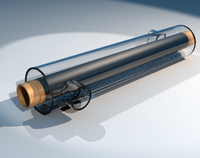
Photo from wikipedia
The areal density achievable with heat-assisted magnetic recording (HAMR) is directly related to the temperature gradient produced in the recording media by the near-field transducer. The thermal gradient in the… Click to show full abstract
The areal density achievable with heat-assisted magnetic recording (HAMR) is directly related to the temperature gradient produced in the recording media by the near-field transducer. The thermal gradient in the down track direction affects the linear density, while the thermal gradient in the cross-track direction determines the achievable track density. While characterizing the cross-track thermal gradient (CTTG) is critical to understanding recording performance in HAMR, to date few details on how to accurately measure this quantity have appeared in the literature. Here, we describe a method to determine the CTTG in HAMR that avoids common distortions such as the cross-track variation in reader sensitivity. It also allows the thermal gradient produced on each side of the head to be measured separately and can measure the pure thermal gradient (without the effect of the magnetic field produced by the pole) or the effective gradient produced by the combination of the thermal gradient and the magnetic field.
Journal Title: IEEE Transactions on Magnetics
Year Published: 2019
Link to full text (if available)
Share on Social Media: Sign Up to like & get
recommendations!